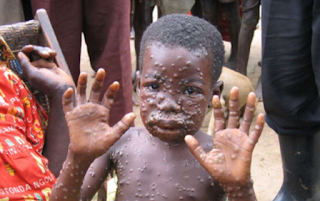Monkeypox: Signs, Symptoms, Causes, Prevention and Treatment
Overview
Monkeypox is a rare viral zoonosis disease that is found in remote parts of Central and West Africa primarily. The monkeypox virus causes a serious illness in humans. It is similar to human smallpox but milder.The monkeypox virus is transmitted from different wild animals to human. It is secondarily spread through human-to-human transmission.
There is no treatment or vaccine available yet, although smallpox vaccination was effective in preventing monkeypox also. Monkeypox symptoms is similar to those seen in smallpox patients, although it is milder.
Monkeypox Outbreaks
Monkeypox is a member of the Orthopoxvirus genus in the family Poxviridae and was first identified in an investigation into a pox-like disease among monkeys in the State Serum Institute in Copenhagen, Denmark, in 1958 .Human monkeypox was first identified in the Democratic Republic of Congo in humans in 1970 in a 9 year old boy. In 2003, monkeypox cases were confirmed in USA, which was the first reported occurrence of the monkeypox outside the African continent.
Causes / Transmission of Monkeypox
Infection results from direct contact with infected animals blood, bodily fluids, cutaneous or mucosal lesions. Hhuman infections have been documented in Africa through the handling of infected Gambian giant rats, monkeys, squirrels and rodents. Also, eating half cooked meat of infected animals is a possible risk factor.
Human-to-human transmission is caused by close contact with respiratory tract secretions and skin lesions of infected person or infected objects. Transmission occurs through droplet respiratory particles especially face-to-face contact. Inoculation or via the placenta (congenital monkeypox) is another mode of transmission.
Human-to-human transmission is caused by close contact with respiratory tract secretions and skin lesions of infected person or infected objects. Transmission occurs through droplet respiratory particles especially face-to-face contact. Inoculation or via the placenta (congenital monkeypox) is another mode of transmission.
Signs and symptoms of Monkey pox
The incubation period, that is interval from infection to onset of symptoms is usually from 6 to 16 days and can range from 5 to 21 days.The incubation period can be divided into two:
- the invasion period (0-5 days) characterized by fever,back pain, headache, myalgia, lymphadenopathy (swelling of the lymph node), and asthenia (lack of energy);
- the skin eruption period within 1-3 days after appearance of fever. Rashes appearearance begins on the face and then spread on other body part. The face (in 95% cases), soles of the feet (75%) and palms of the hands are mostly affected.
Lesions affect oral mucous membranes ( 70% of cases), genitalia (30%), eyelid (20%), and also the cornea (eyeball).
Some patients may develop severe lymphadenopathy before rashes appearance.
Some patients may develop severe lymphadenopathy before rashes appearance.
Diagnoses
Monkeypox can only be diagnosed in the laboratory a number of tests:
- enzyme-linked immunosorbent assay (ELISA)
- polymerase chain reaction (PCR) assay
- antigen detection tests
- virus isolation by cell culture
Treatment and Vaccine
The outbreaks of monkeypox can be put to control , although there is no specific treatments or vaccines available yet.
Prevention of Monkeypox
To prevent monkeypox during human monkeypox outbreaks, close contact with infected person is a risk factor for monkeypox virus. Awareness of the risk factors of monkeypox should be ensured. it is important to educate people about the measures they can take to reduce exposure to the disease.
Monkeypox expansion can be prevented through restrictions on animal trade. Infected animals and animals that might have come into contact with an infected animal should be isolated and placed into quarantine and observed for monkeypox symptoms for 30 days.
Gloves and protective equipment should be worn when treating ill people. A Regular hand washing should be ensured after visiting or caring for sick people. Thorough cooking of all animal products should be ensured before eating. Also, Gloves and other protective clothing should be worn while handling sick animals.
Gloves and protective equipment should be worn when treating ill people. A Regular hand washing should be ensured after visiting or caring for sick people. Thorough cooking of all animal products should be ensured before eating. Also, Gloves and other protective clothing should be worn while handling sick animals.



Comments